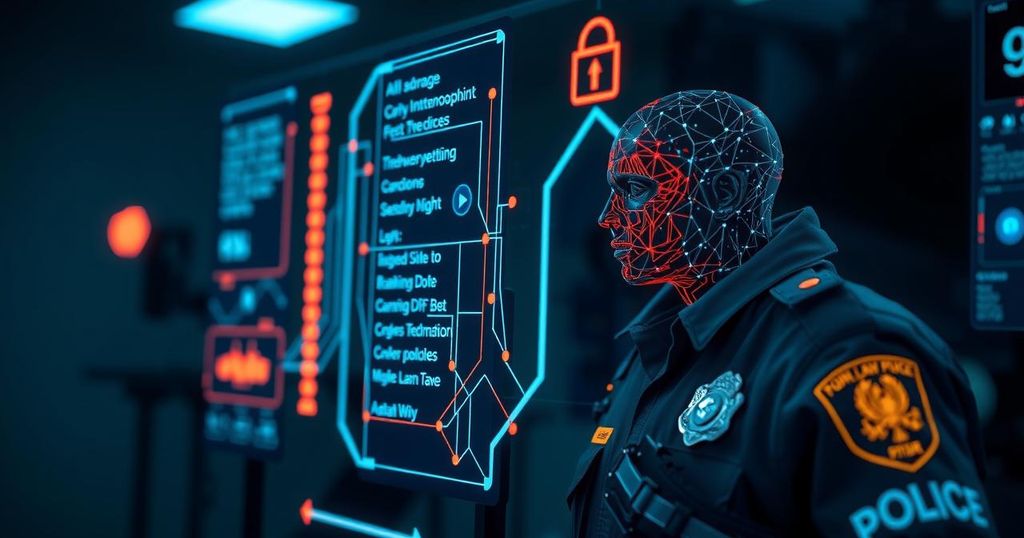This article emphasizes the growing role of artificial intelligence (AI) in policing, highlighting the complex accountability it demands. As AI technologies are adopted, law enforcement agencies must ensure transparency and understanding of their applications, particularly in operational contexts. The article underscores the need for rigorous oversight and public communication in order to maintain trust in policing practices as AI evolves.
Artificial intelligence (AI) is transforming policing, demanding greater accountability in the process. AI’s integration into law enforcement not only enhances capabilities but also complicates the frameworks of accountability. Officers must face critical questions about the functionality and rationale of AI systems deployed within their departments. This level of transparency is crucial, especially when technology is used in operational contexts vs. administrative tasks. The stakes are particularly high when AI applications involve intrusive methods like biometric surveillance, necessitating stricter oversight and understanding of the technology. With the advent of AI in policing, a nuanced approach to accountability is required. Utilizing AI for tasks like issuing uniforms bears similar risks to administrative work in other public sectors. However, implementations involving operational policing heighten accountability issues. The distinctions between the uses of AI—whether it’s for mundane administrative purposes or critical real-time policing applications—must be understood and communicated clearly to foster public trust. AI’s increasing complexity necessitates a responsive framework for accountability, informed by existing regulatory structures like the EU AI Act. Historically, UK policing incorporates various technologies, underscoring the need for robust oversight mechanisms that align with the novel nature of AI. Unlike previous innovations, the introduction of Artificial General Intelligence (AGI) and its implications require proactive measures to ensure responsible use. As law enforcement embraces AI’s multifaceted applications, the challenge lies in distinguishing between ethical applications and the potential for misuse, driving the need for stringent auditing processes. The demand for accountability intensifies as AI’s capabilities extend beyond traditional constraints. Police departments must articulate their criteria for AI use and the limitations imposed on them in terms of scope. Public communication about the technology’s constraints is vital, particularly in the UK context, which emphasizes consent-based policing. This emphasizes proactive measures such as the AIPAS project, aiming to develop frameworks and tools that facilitate responsible AI application in law enforcement. Police forces have a critical role in ensuring that their deployment of AI upholds public trust; thus, maintaining a consistent narrative around their responsibilities while leveraging AI becomes paramount. As AI evolves, so too must accountability structures, ensuring that emerging technologies are balanced against public expectations and concerns. \n The relationship between law enforcement and AI must navigate a complex landscape where innovation and assurance coexist. Ensuring citizen safety while addressing technology’s profound implications will become crucial in sustaining the integrity of policing practices, reinforcing that accountability is not simply a reactive measure but a proactive necessity.
The article discusses the integration of artificial intelligence within policing and the resulting demands for increased accountability. Historically, law enforcement agencies have controlled various technologies, but the arrival of AI alters that relationship due to its capability to affect civil liberties and privacy. The nuances of accountability in policing are explored, highlighting how AI’s complex algorithms and broad usability require a thorough understanding and structured evaluation.
In conclusion, as AI integrates into policing, the need for enhanced accountability mechanisms is critical. This involves rethinking traditional accountability models, fostering transparency about AI applications, and ensuring effective auditing processes. As AI enables unprecedented capabilities in law enforcement, maintaining public trust relies on responsibly managing these technologies and communicating openly with citizens about their use and implications. Establishing frameworks like the AIPAS project may be foundational in shaping a trustworthy relationship between police and public regarding AI’s role in security.
Original Source: www.biometricupdate.com





